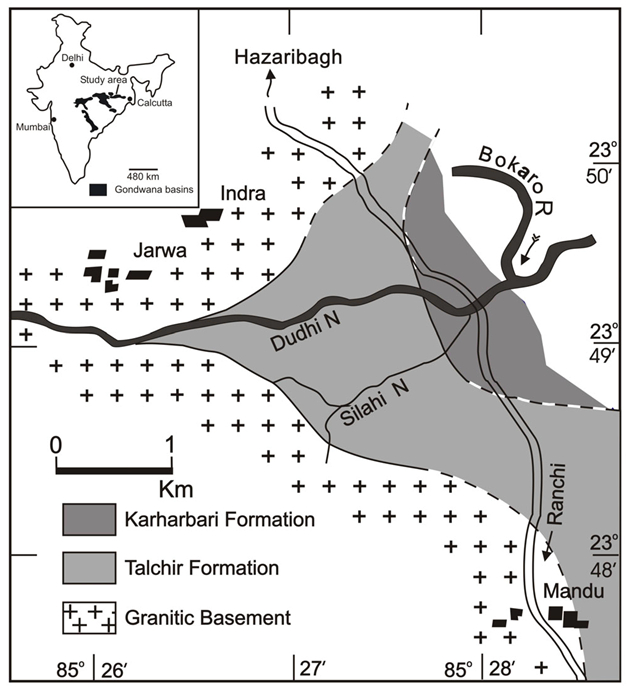Karharbari Fm
Type Locality and Naming
Named after Karharbari village, Giridih Coalfield, Bihar by Blanford (1878 b); designated as formation by Ghosh et al. (1964), Ghosh and Basu (1967). Original Publication: Blanford, W.T. 1878.On the stratigraphy and homotaxis of the Kota-Maleri deposits. Pal. Ind. Ser. 4, pt. 2, 17-23; Ghosh, P.K., Deekshitulu, M.N. and Narayan Murthy B.R., 1964.-The Karharbari in the Gondwana of Peninsular India. Rep. XXII, Int. Geol. Cong., pt. 3, 169-180; Ghosh. P.K . and Basu, A. 1967. Stratigraphic position of the Karharbari in the lower Gondwanas of India, 1st. Int. Symp. on Gond. Strat. I.U.G.S., Buenos Aires. 107-117]
[Figure 1: Geological map showing Talchir Formation and Karharbari Formation in the western part of West Bokaro Coal basin (after Bhattacharya et al., 2005)]
Lithology and Thickness
Sandstone. The litho units consist of grey to brown mottled carbonaceous sandstones, grits and conglomerates with occasional coal seams and fire clays. The sandstones are usually dirty white that also contain reworked clasts of shale and sandstone of the Talchir Fm. Karharbari coals are generally unbanded and dull. Good workable seems occur in Giridih. In the type area, the formation is about 60-120 m thick (Dutta, 1971).
[Figure 2: Litholog of the Karharbari Formation in Dudhi nala in the western part of West Bokaro Coal basin (Bhattacharya et al., 2005)]
Relationships and Distribution
Lower contact
Gee (1928) and Fox (1931a,b) opined that Karharbari unconformably overlies the Talchir Fm, but Fiestmantel (1882), Ahmad (1957), Sastry and Shah (1964), Maithy (1966b) suggest a conformable contact of Karharbari with underlying Talchir Fm. At most places, the lower contact of Karharbari Formation with the Talchir is gradational and conformable (Peters, 2009).
Upper contact
Although Ghosh et al. (1964), Ghosh and Basu (1967) noticed local pebble beds in between Barakar and the Karharbari Fm, the upper contact with the Barakar Formation is gradational.
Regional extent
It has been recorded from almost all areas of Lower Gondwana successions in Peninsular India. Mappable beds are exposed in Raniganj, Karanpura, Deogarh, Daltonganj, Hutar, Hasdo-Arand, Mohpani, areas etc. (Sastry et al., 1977).
GeoJSON
Fossils
Acritarchs: Balmella, Brazilea, Faveofusa, Leiosphaerdea, Tetraporina (Banerjee 1987a); Megaflora, dominated by Gangamopteris and Noeggerathiopsis are known from Karharbari Formation. Some characteristic megafloral forms are Rubidgea, Karharbariphyllum, Euryphyllum, Botrychiopsis, Buriadia hetrophylla, Palmatophyllites, Cordaicarpus, Samaropsis and Rotundocarpus. Glossopteris, Paraanocladus sahnii, Phyllotheca and Giridia has also been reported (Maithy, 1966, 1969; Banerji, 1987, Bose et al., 1989, Singh et al., 1998). Among
miospores, Plicatipollenites, Virkipollenites, Parasaccites, Ptoneisporites, Crucisaccites are known (Maithy, 1965 f; Peters, 2009).
Age
Depositional setting
Karharbari lithofacies forms fining-upward cycles. A complete cycle consists of conglomerate or coarse-grained sandstone at the base sequentially succeeded by medium- and fine-grained sandstones, shale and coal at the top. Cyclic sedimentation of the Karharbari Formation was controlled by autocyclic process by means of lateral migration of streams activated by intrabasinal differential subsidence, which operated within the depositional basin and the channels carrying coarse grade clastic sediments, which make the cycles thicker, tend to be more common in the areas of maximum subsidence (Hota and Sahoo, 2009).
Additional Information
References
Acharya et al., 1977; Ahmad 1957; Banerjee, M. 1987a ; Blanford, W.T. 1878. On the stratigraphy and homotaxis of the Kota-Maleri deposits. Pal. Ind.; Ser. 4, pt. 2, 17-23.; OR; Blanford, W.T. 1 878.-The palaeontological relations of the Gondwana System : a reply to Dr.; Feistmantel. Rec. Geol. Surv. Ind., 11(1), 1-160. ; Bose et al., 1989; Dutta, 1971; Fiestmantel 1882; Fox 1931a,b ; Gee 1928; Ghosh, P.K., Deekshitulu, M.N. and Narayan Murthy B.R., 1964. The Karharbari in the Gondwana of Peninsular India. Rep. XXII, Int. Geol. Cong., pt. 3, 169-180; Ghosh. P.K . and Basu, A. 1967. Stratigraphic position of the Karharbari in the lower Gondwanas of India, 1st. Int. Symp. on Gond. Strat. I.U.G.S., Buenos Aires. 107-117; Hota, R.N., Sahoo, M. 2009. Cyclic sedimentation of the Karharbari Formation (Damuda Group), Talchir Gondwana basin, Orissa. Journal of the Geological Society of India volume 73, ; Maithy 1965f, 1966b, 1969 ; Peters, 2009; Sastry and Shah 1964; Sastry et al., 1977; Singh et al., 1998;

